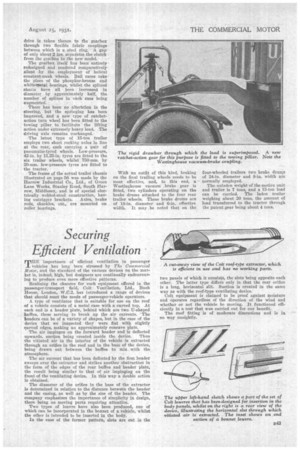THE BEARDMORE 1 5-ToN OUTFIT
Page 56

Page 57

If you've noticed an error in this article please click here to report it so we can fix it.
in its latest form
THE unique features of what used to be the Chenard-'Walektr tractortrailer outfit are well known to our readers, particularly, of course, the interlocking-ring turntable and the way in which the trailer weight is partly trans
ferred to the tractor. Since William Beardmore and Co., Ltd., took over the manufacturing rights for this country, that is, since our road-test report appeared in The Commercial Yotor on December 24th, 1929, much research work has been undertaken, the result of which is seen in the latest form of the Beardmore 15-ton outfit. The first examples of this outfit are now in users' hands. The London depot of the Beardmore concern is at Park Crescent, Clapham Park Road, London, S.W.4.
In the first place, a Meadows engine bon adopted, this being the type6E IN, six-cylindered power unit.of 115 unn, bore and 130 mm. stroke, which develops 90 b.h.p. It has a Simms magneto with automatic-advance device, and the carburetter issia Solex. The fan is
gear driven through a friction clutch and the engine carries a water pump and an A.C. fuel pump.
This engine being longer than that previously used, it has been necessary to increase the length of the tractor frame, but the balance of the engine over the front axle has been preserved by moving the axle slightly forward. The engine is mounted at three points upon rubber blocks, the front mounting being in the form of a truhnion, and the radiator, which is deeper than in the past, has two trunnion mountings.
The 16-in, single-plate clutch now forms a unit with the engine, and the drive is taken thence to the gearbox through two flexible fabric couplings between which is a steel ring-. A gap of only about 2 ins. separates the clutch from the gearbox in. the new model.
The gearbox itself has • been entirely redesigned and rendered comparatively silent • by the employment of helical constant-mesh wheels. all races take the place of the phosphor-bronze and ,white-'metal bearings, whilst the splined sharts have all been increased in diameter by approximately half, the number of splines in each case being augmented.
There has been no alteration in the steering, but the springing has been improved, and a new type of ratchetaction turn wheel has been fitted to the towing pillar to facilitate the lifting action under extremely heavy load. The driving axle remains unchanged.
-The latest type of 15-ton trailer employs two short rocking axles in line at the rear, each carrying a pair of pneumatie-tyred wheels. Low-pressure, 42-in. by 11.25-in, tyres are fitted to the six trailer wheels, whilst 750-mm. by 20-mm. low-pressure tyres are fitted to the tractor.
The frame of the actual trailer chassis illustrated on page 56 was made by the llarrow Industrial Co., Ltd., of Green Lane Works, Stanley Road, South Harrow, Middlesex, and is of special electrically welded-steel construction, bay ing outrigger brackets. Axles, brake rods, shackles, etc., are mounted on roller. bearings,
With an outfit of this kind, braking On the final trailing wheels needs to be most effective, and, to this end, a Westinghouse vacuum brake gear is fitted, two cylinders operating on the brake drums attached to the four rear trailer wheels. These brake drums are of 18-in, diameter and 6.-in. effective width. It may be noted that on the
four-wheeled trailers two brake drums of 24-in, diameter and 8-in, width are normally employed.
The unladen weight of the motive unit and trailer is 7 tons, and a 15-ton load can be carried. The laden trailer weighing about 20 tons, the amount of load transferred to the tractor through the patent gear being about 4 tons.




























































































